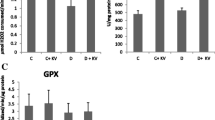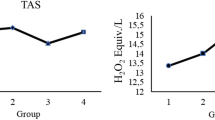Abstract
The streptozotocin-induced short-term (2 week) diabetic rats showed an increase in susceptibility to carbon tetrachloride (CCl4)-induced hepatocellular damage. This diabetes-induced change was associated with a marked impairment in the hepatic glutathione antioxidant/detoxification response to CCl4 challenge, as indicated by the abrogation of the increases in hepatic reduced glutathione (GSH) level, glucose-6-phosphate dehydrogenase and microsomal glutathione S-transferases (GST) activities upon challenge with increasing doses of CCl4. While the hepatic GSH level was increased in diabetic rats, the hepatic mitochondrial GSH level and Se-glutathione peroxidase activity were significantly reduced. Insulin treatment could reverse most of the biochemical alterations induced by diabetes. Both insulin and schisandrin B (Sch B) pretreatments protected against the CCl4 hepatotoxicity in diabetic rats. The hepatoprotection was associated with improvement in hepatic glutathione redox status in both cytosolic and mitochondrial compartments, as well as the increases in hepatic ascorbic acid level and microsomal GST activity. The ensemble of results suggests that the diabetes-induced impairment in hepatic mitochondrial glutathione redox status may at least in part be attributed to the enhanced susceptibility to CCl4 hepatotoxicity. Sch B may be a useful hepatoprotective agent against xenobiotics-induced toxicity under the diabetic conditions. (Mol Cell Biochem 175: 225–232, 1997)
Similar content being viewed by others
References
Jakoby WB, Zeigler DM: The enzymes of detoxication. J Biol Chem 265: 20715–20718, 1990
Mak DHF, Ip SP, Li PC, Poon MKT, Ko KM: Alterations in tissue glutathione antioxidant system in streptozotocin-induced diabetic rats. Mol Cell Biochem 162: 153–158, 1996
Aniya Y, Ojiri Y, Sunagawa R, Murakami K, Zhenzhong G, Mimura G, Sakanashi M: Glutathione S-transferases and chloroform toxicity in streptozotocin-induced diabetic rats. Jpn J Pharmacol 50: 263–269, 1989
Thomas H, Schladt L, Knehr M, Oesch F: Effect of diabetes and starvation on the activity of rat liver epoxide hydrolases, glutathione S-transferases and perioxisomal β-oxidation. Biochem Pharmacol 38: 4291–4297, 1989
Grant MH, Duthie SJ: Conjugation reactions in hepatocytes isolated from streptozotocin-induced diabetic rats. Biochem Pharmacol 30: 3647–3655, 1987
Thomas PE, Bandiera S, Maines SL, Ryan DE, Levin W: Regulation of cytochrome P-450j, a high-affinity N-nitrosodimethylamine demethylase, in rat hepatic microsomes. Biochemistry 26: 2280–2289, 1987
Barnett CR, Flatt PR, Ioannides C: Role of ketone bodies in the diabetes-induced changes in hepatic mixed-function oxidase activities. Biochim Biophys Acta 967: 250–254, 1988
Watkins JB III, Sanders RA, Beck LV: The effect of long-term streptozotocin-induced diabetes on the hepatotoxicity of bromobenzene and carbon tetrachloride and hepatic biotransformation in rats. Toxicol Appl Pharmacol 93: 329–338, 1988
Barnett CR, Abbott RA, Bailey CJ, Flatt PR, Ioannides C: Cytochrome P450-dependent mixed-function oxidase and glutathione S-transferases activities in spontaneous obesity-diabetes. Biochem Pharmacol 43: 1868–1871, 1992
Li XY: Bioactivity of neolignans from Fructus Schizandrae. Mem Inst Oswaldo Cruz Rio de Janeiro 86: 31–37, 1991
Ip SP, Poon MKT, Wu SS, Che CT, Ng KH, Kong YC, Ko KM: Effect of schisandrin B on hepatic glutathione antioxidant system in mice: Protection against carbon tetrachloride toxicity. Planta Med 61: 398–401, 1995
Evans WH: Isolation and characterization of membranes and cell organelles. In: D Rickwood (ed). Preparative Centrifugation: A Practical Approach. New York, Oxford University Press, 1992, pp 233–270
Reed DJ, Babson JR, Beatty PW, Brodie AK, Ellis WW, Potter DW: High performance liquid chromatography analysis of nanomole levels of glutathione, glutathione disulfide, and related thiols and disulfides. Anal Biochem 106: 55–62, 1980
Ip SP, Ko KM: The crucial antioxidant action of schisandrin B in protecting against carbon tetrachloride hepatotoxicity in mice: A comparative study with butylated hydroxytoluene. Biochem Pharmacol 52: 1687–1693, 1996
Liau LS, Lee BL, New AL, Ong CN: Determination of plasma ascorbic acid by high performance liquid chromatography with ultraviolet and electrochemical detection. J Chromatogr 612: 63–70, 1993
Recknagel RO, Glende EA Jr: The carbon tetrachloride hepatotoxicity model: Free radical and calcium homeostasis. In: J Miquel, AT Quintanilha, H Weber (eds). Handbook of Free Radicals and Antioxidants in Biomedicine. Boca Raton, CRC Press, 1989, Vol III, pp 1–16
Reiter R, Burk RF: Formation of glutathione adducts of carbon tetrachloride metabolites in a rat liver microsomal incubation system. Biochem Pharmacol 37: 327–331, 1988
Lu SC, Ge JL, Kuhlenkamp J, Kaplowitz N: Insulin and glucocorticoid dependence of hepatic gamma-glutamylcysteine synthetase and glutathione synthesis in the rat. Studies in cultured hepatocytes and in vivo. J Clin Invest 90: 524–532, 1992
Pascoe GA, Reed DJ: Cell calcium, vitamin E, and the thiol redox system in cytotoxicity. Free Radic Biol Med 6: 209–224, 1989
Pascoe GA, Olafsdottir K, Reed DJ: Vitamin E protection against chemical-induced cell injury. I. Maintenance of cellular protein thiols as a cytoprotective mechanism. Arch Biochem Biophys 256: 150–158, 1987
Younes M, Siegers CP: The role of iron in the paracetamol-and CCl4-induced lipid peroxidation and hepatotoxicity. Chem-Biol Interact 55: 327–334, 1985
Tohgi H, Abe T, Saheki M, Hamato F, Sasaki K, Takahashi S: Reduced and oxidized forms of glutathione and alpha-tocopherol in the cerebrospinal fluid of Parkinsonian patients: Comparison between before and after L-dopa treatment. Neurosci Lett 184: 21–24, 1995
Videla LA, Valenzuela A: Alcohol ingestion, liver glutathione and lipoperoxidation: metabolic interrelations and pathological implications. Life Sci 31: 2395–2407, 1982
Ferrari R, Ceconi C, Curello S, Pasini E, Visioli O: Protective effect of propionyl-L carnitine against ischaemia and reperfusion-damage. Mol Cell Biochem 88: 161–168, 1989
Winkler BS, Orselli SM, Rex TS: The redox couple between glutathione and ascorbic acid: A chemical and physiological perspective. Free Radic Biol Med 17: 333–349, 1994
Andersson C, Mosialou E, Weinander R, Morgenstern R: Enzymology of microsomal glutathione S-transferases. Adv Pharmacol 27: 19–35, 1994
Mico BA, Pohl LR: Reductive oxygenation of carbon tetrachloride: trichloromethylperoxyl radical as a possible intermediate in the conversion of carbon tetrachloride to electrophilic chlorine. Arch Biochem Biophys 225: 596–609, 1983
Manno M, De Matteis F, King LJ: The mechanism of the suicidal, reductive inactivation of microsomal cytochrome P-450 by carbon tetrachloride. Biochem Pharmacol 37: 1981–1990, 1988
Commandeur JNM, Stijntjes GJ, Vermeulen NPE: Enzymes and transport systems involved in the formation and disposition of glutathione S-conjugates. Pharmacol Rev 47: 271–330, 1995
Liu KT, Lesca P: Pharmacological properties of dibenzo[a,c]cyclooctene derivatives isolated from Fructus Schizandrae chinensis III. Inhibitory effects on carbon tetrachloride-induced lipid peroxidation, metabolism and covalent binding of carbon tetrachloride to lipids. Chem-Biol Interact 41: 39–47, 1982
Author information
Authors and Affiliations
Rights and permissions
About this article
Cite this article
Mak, D.H., Ko, K. Alterations in susceptibility to carbon tetrachloride toxicity and hepatic antioxidant/detoxification system in streptozetocin-induced short-term diabetic rats: Effects of insulin and Schisandrin B treatment. Mol Cell Biochem 175, 225–232 (1997). https://doi.org/10.1023/A:1006883919687
Issue Date:
DOI: https://doi.org/10.1023/A:1006883919687




